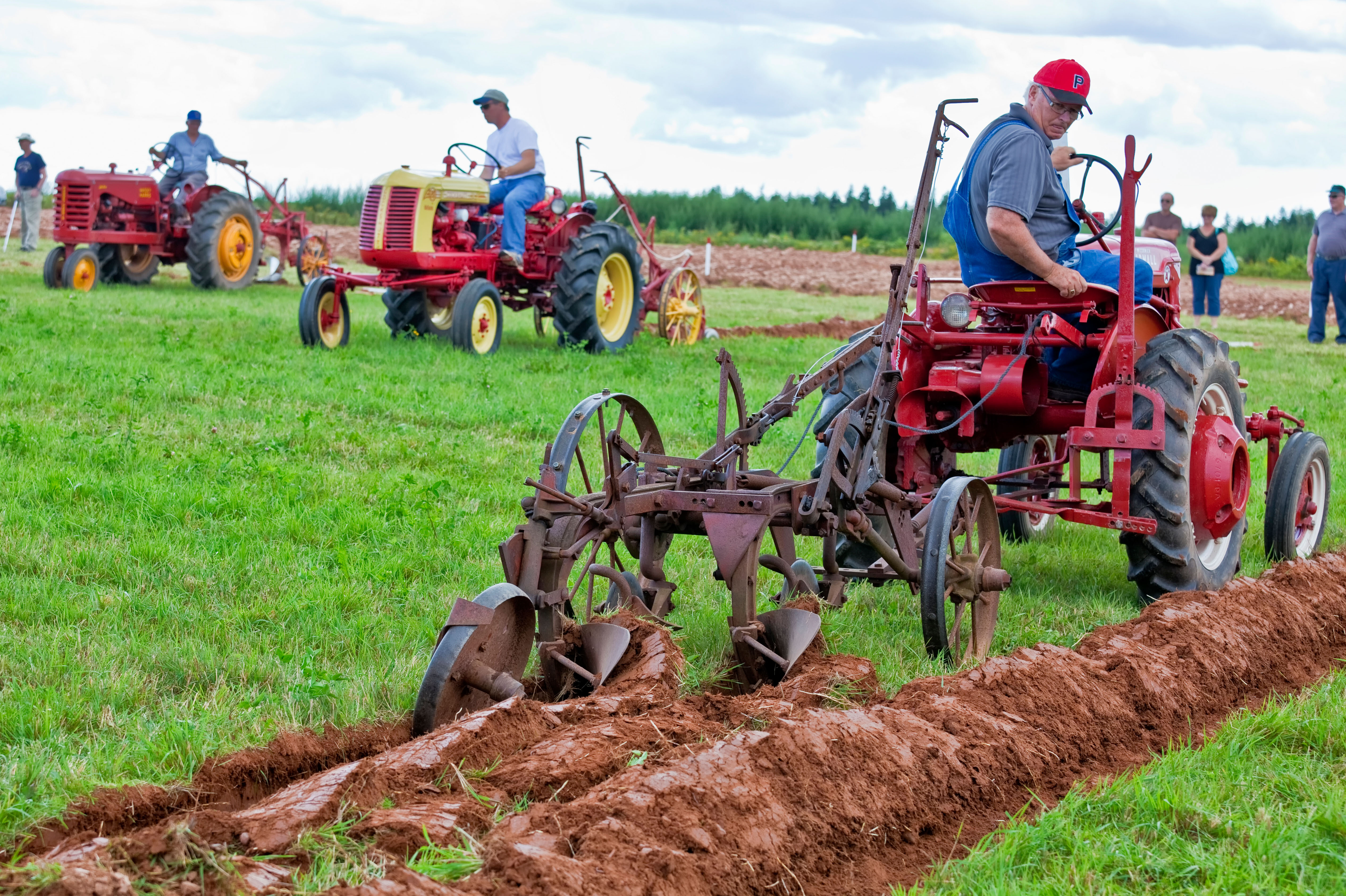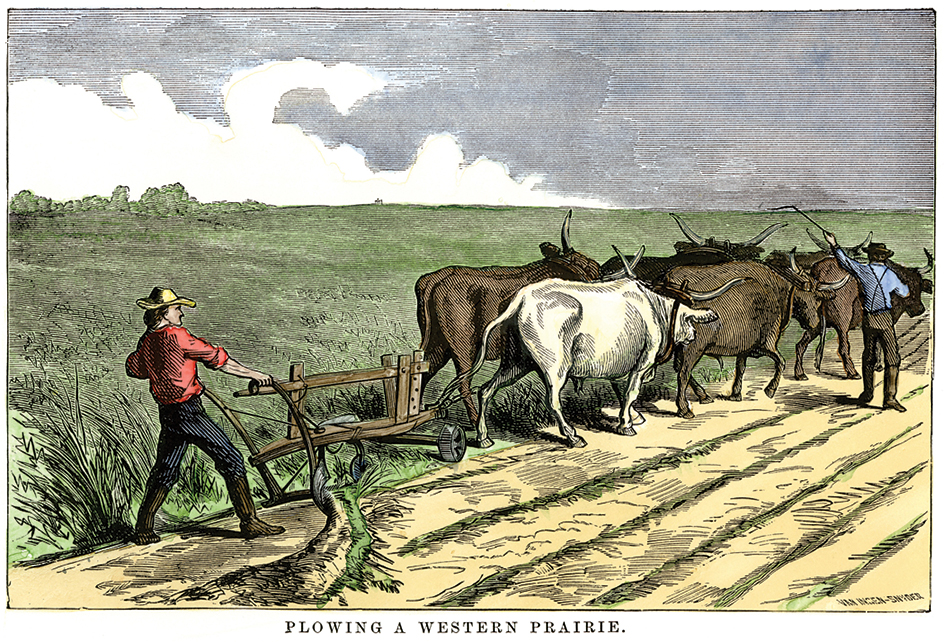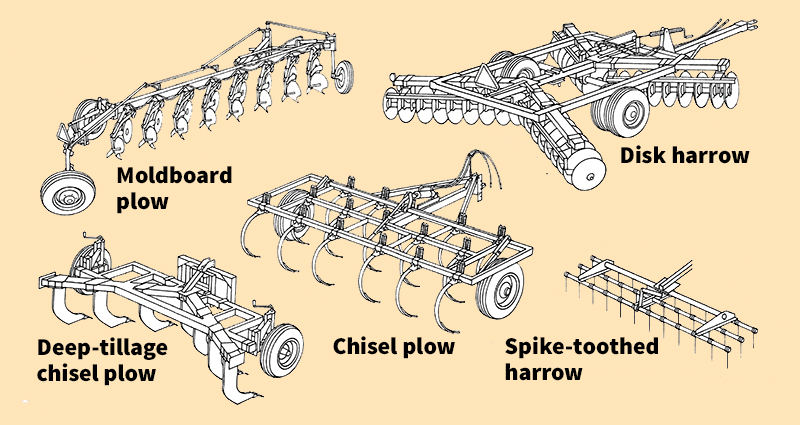Plow is a tool that is used to prepare soil for planting. The term plow is also used to refer to other types of equipment, such as vehicles used to clear snow from streets and machines that dig trenches for laying cables. This article discusses only plows used in farming.

A plow digs into the ground and pushes, cuts, and lifts the soil to break it up. Much of the food in the world comes from crops that have been grown in plowed fields and from food-producing animals that feed on such crops.
Farmers till (plow) the soil for many reasons. For example, plowing reduces the hardness of the upper 6 to 16 inches (15 to 41 centimeters) of the ground, making seed planting easier. Tillage also aids planting by covering up the residue (remains) of the previous crop and by killing weeds and insects. In addition, air movement into the ground increases, and oxygen can act more quickly on organic matter in the soil to speed the release of plant nutrients. Plants growing in the soil can also take in more oxygen through their roots and thus grow more rapidly.
Kinds of plows
There are four chief kinds of plows: (1) the tractor plow, (2) the walking plow, (3) the sulky plow, and (4) the gang plow. In developed countries, almost all farmers use a tractor plow. Most farmers in less developed countries use a walking plow. Sulky plows and gang plows are rarely used today. Practically all plows used today are made of iron and steel, but some are built of wood.
The tractor plow
is pulled by a tractor. This type of plow has from 1 to 10 or more bottoms (furrowing spades) mounted on its frame. Colters (disk blades) can also be mounted on the frame to cut residue.
The walking plow
is pulled by horses, mules, or oxen. The farmer must walk behind and hold the handles to guide the plow.

The sulky plow
has a seat and wheels, and so the farmer can ride while tilling. Horses pull the sulky plow, which was invented in 1875 by John Deere, an Illinois blacksmith.
The gang plow,
a horse- or tractor-drawn plow, also allows the farmer to ride while tilling. It has two or more bottoms and three wheels. A gang plow can till as many furrows at a time as it has bottoms. A walking plow and a sulky can till only one at a time.
Kinds of plow bottoms
Farmers also classify plows according to the types of bottoms they have. One of the most widely used type is the moldboard plow bottom.
The moldboard plow bottom
molds (covers and buries residue) as it tills. It has three main parts: (1) the share, (2) the landside, and (3) the moldboard. They are bolted onto a frame called the frog, which holds them together in the shape of a three-sided wedge.
The share
is the sharp edge that cuts the furrow slice loose from the ground. The share uses most of the power required to pull the plow bottom through the soil.
The landside
fits behind the point of the share and below the moldboard. It slides along the land at the bottom of the furrow, where a slice of soil has been cut out, and stabilizes the plow.
The moldboard
is above and to the rear of the share. It turns the soil, breaks it up, and moves it to one side. Farmers use four types of moldboards. A stubble moldboard is short and sharply curved. Farmers may use it for slow plowing in soils that scour (slide cleanly off the moldboard). A general-purpose moldboard has a longer curve and is useful for average scouring conditions and plowing speeds. A high-speed moldboard has an even longer curve and can plow at higher speeds without throwing the soil too far to the side. A slatted moldboard consists of long curved steel slats, which provide little surface area for sticky soils to cling to.

Other types of plow bottoms
provide greater efficiency than moldboards in certain situations. The bottom of a disk plow consists of a disk-shaped blade designed to till hard, sticky, or stony land. The chisel plow has narrow, C-shaped bottoms. Chisel plows lift the soil without turning it over. This action leaves crop residue on the surface where it can reduce the erosion (wearing away) of soil that results from the movement of wind and water. A rotary plow has many bent rotating blades that mix residue with the soil.
History
The people of most prehistoric civilizations never tilled the soil. They merely punched holes in the ground with a stick to bury the seed and hide it from birds and rodents. Then, more than a million years ago, people discovered that plants grew better in soil that had been loosened. They began to use such objects as sharp sticks, rocks, bones, or shells to pry loose chunks of dirt before planting the seed.
The first plow was made about 8,000 years ago. A farmer sharpened one prong of a forked branch to turn the soil and probably hitched a person to the other prong. The farmer guided the implement by holding the branch’s stump while the other person pulled. Later, oxen were used to pull the plow, and a pointed iron spade replaced the bottom prong.
See also Deere, John .
